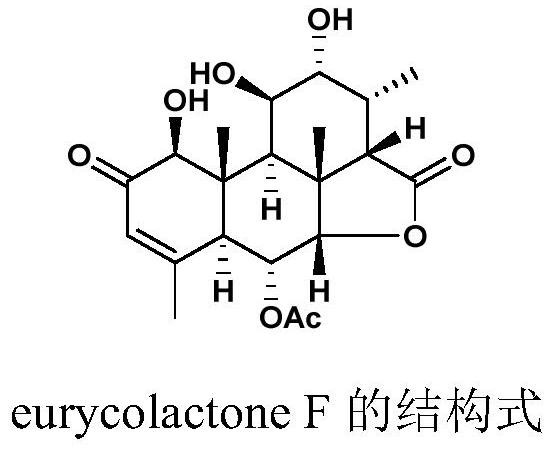Insect antifeedant eurycolactone F conducted in plants and its application
A plant and insect technology, applied in the fields of plant growth regulators, applications, and repellents, can solve the problems of losing efficacy and being easily affected by the interference of the external environment, and achieves high antifeedant activity and convenient use.
- Summary
- Abstract
- Description
- Claims
- Application Information
AI Technical Summary
Problems solved by technology
Method used
Image
Examples
Embodiment 1
[0026] Example 1 eurycolactone F can be sucked into the root of Chinese cabbage from the growth environment of Chinese cabbage through the root, and transported upward to the leaves, so that insects refuse to eat the leaves of Chinese cabbage
[0027] Method: Dissolve eurycolactone F in DMSO to make a mother solution of 10000μg / mL, and then use 0.5mM CaCl 2 Dilute the stock solution with aqueous solution to 100 μg / mL culture solution. The previously cultivated untreated Chinese cabbage seedlings (6-leaf stage) were placed in 0.5mM CaCl 2 After pre-cultivation in aqueous solution for 2 hours, transfer it into the 100 μg / mL eurycolactone F culture solution prepared above. After 24 hours of cultivation, take 0.55 g of the top leaf of Chinese cabbage, mash it, dissolve it in 2 mL of methanol, and use liquid chromatography- Mass spectrometry can detect that the extract contains eurycolactone F. After calculation, the content of eurycolactone F in the top leaves (fresh leaves) of ...
Embodiment 2
[0033] Example 2: Detecting the antifeedant activity of eurycolactone F to several leaf-eating Lepidoptera larvae that damage vegetables by the method of drug loading on leaf discs
[0034] Method: Dissolve eurycolactone in methanol to prepare a 2000 μg / mL mother solution, then dilute the mother solution with acetone to 5, 10 and 20 μg / mL solutions and spread them evenly on the surface of a circular cabbage leaf dish with a diameter of 1.5 cm. The amount of drug applied to each leaf dish was 20 μL. After the acetone on the surface of the leaf dish was naturally dried, the 2nd instar larvae of the diamondback moth Plutellaxylostella (Linnaeus) were inserted, and each concentration treatment was repeated 3 times. After keeping in an environment with a temperature of 25° C. to 28° C. for 24 hours, the feeding area was counted, and the feeding rate and refusal rate were calculated. See Example 1 for the calculation formula.
[0035] Cassava leaves were used to test the antifeedant...
Embodiment 3
[0039] Example 3: eurycolactone F can be sucked into the root of Chinese cabbage from the growth environment of Chinese cabbage through the root, and transported upward to the leaves, so that the cabbage aphid Lipaphiserysimi refuses to eat the leaves of Chinese cabbage
[0040] Experimental method: Dissolve eurycolactone F in methanol to make a mother solution of 10000μg / mL, and then use 0.5mMCaCl 2 Dilute the stock solution with aqueous solution to 100 μg / mL culture solution. The previously cultivated cabbage seedlings (6-leaf stage, not treated with eurycolactone F before) were placed in 0.5mM CaCl 2 After pre-cultivation in aqueous solution for 2 hours, transfer to the above-mentioned eurycolactone F culture solution that has been prepared. After 24 hours, insert the aphid without wings, insert 100 heads in each cage, repeat 4 times, and count the control leaves after 24 hours after inserting the aphid. and the number of cabbage aphids perched on the treated leaves, the f...
PUM
 Login to View More
Login to View More Abstract
Description
Claims
Application Information
 Login to View More
Login to View More - Generate Ideas
- Intellectual Property
- Life Sciences
- Materials
- Tech Scout
- Unparalleled Data Quality
- Higher Quality Content
- 60% Fewer Hallucinations
Browse by: Latest US Patents, China's latest patents, Technical Efficacy Thesaurus, Application Domain, Technology Topic, Popular Technical Reports.
© 2025 PatSnap. All rights reserved.Legal|Privacy policy|Modern Slavery Act Transparency Statement|Sitemap|About US| Contact US: help@patsnap.com



